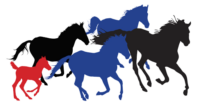In the Wild Horses and Burros Act of 1971, Congress found and declared that “wild free-roaming horses and burros are living symbols of the historic and pioneer spirit of the West; that they contribute to the diversity of life forms within the Nation and enrich the lives of the American people; and that …it is the policy of Congress that wild free-roaming horses and burros shall be protected … and … considered …as an integral part of the natural system of the public lands.” Notice that they are referred to as “wild and free-roaming”, not "feral".
Mustangs have played a significant role in changing the practical, cultural, and spiritual lives of our forebearers and indigenous peoples throughout the Americas, but unfortunately, they have been mistakenly labeled non-native or feral. They are in fact native. Current molecular biology reveals that E. caballus DNA is genetically equivalent to the prehistoric ancestral Equus species. (E. caballus is the more correct descriptive term, over the more widely used term Eohippus.)
According to the late Jay Kirkpatrick, noted Cornell-trained reproductive veterinary physiologist, “Two key element for defining an animal as a native species are where it originated and whether or not it co-evolved with its habitat. E. caballus can lay claim to doing both in North America.”
